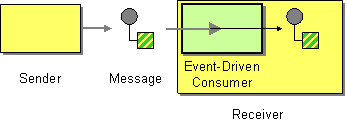...
The Event-Driven Consumer EIP allows an application to automatically consume messages as they become available. For more information, refer to http://www.eaipatterns.com/EventDrivenConsumer.html.
Figure 1: Event-Driven Consumer EIP
...
Before digging into implementation details, let's take a look at the relationship between the example scenario and the Event-Driven Consumer EIP by comparing their core components.
| Event-Driven Consumer EIP (Figure 1) | Event-Driven Consumer Example Scenario (Figure 2) |
|---|---|
| Sender | Simple Stock Quote Client |
| Message | Simple Stock Quote Request |
| Event Driven Consumer | Event Mediator |
| Receiver | Topic Subscriber, Simple Stock Quote Service |
Environment setup
- Download and install WSO2 ESB from http://wso2.com/products/enterprise-service-bus. For a list of prerequisites and step-by-step installation instructions, refer to Installation Guide in the WSO2 ESB documentation.
- Start two sample Axis2 server. For instructions, refer to the section section Setting Up the ESB Samples - Starting the Axis2 server in the WSO2 ESB documentation.
- Follow the steps below to create an event.
- Start the ESB server and log into its management console UI (
https://localhost:9443/carbon). - Select the Topics menu from the Main menu and then select the Add sub menu.
- Enter
EventConsumerTopicas the name for the topic, and then click Add Topic. - Click the newly created topic EventConsumerTopic in the topic browser tree and click Subscribe to create a static subscription.
- Enter the value
http://localhost:9000/services/SimpleStockQuoteServicein the Event Sink URL field and click Subscribe.
- Start the ESB server and log into its management console UI (
...
| Code Block | ||||
|---|---|---|---|---|
| ||||
<?xml version="1.0" encoding="UTF-8"?>
<definitions xmlns="http://ws.apache.org/ns/synapse">
<sequence name="fault">
<log level="full">
<property name="MESSAGE" value="Executing default "fault" sequence"/>
<property name="ERROR_CODE" expression="get-property('ERROR_CODE')"/>
<property name="ERROR_MESSAGE" expression="get-property('ERROR_MESSAGE')"/>
</log>
<drop/>
</sequence>
<sequence name="main">
<log/>
<event topic="EventConsumerTopic"/>
</sequence>
</definitions> |
...
